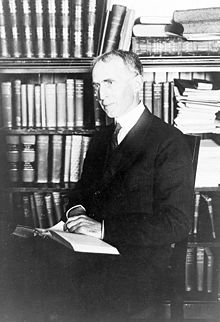Public administration theory
Appearance
Public administration theory, the science of administration, or short public administration, is the amalgamation of history, organizational theory, social theory, political theory and related studies focused on the meanings, structures and functions of public service in all its forms. It often recounts major historical foundations for the study of bureaucracy as well as epistemological issues associated with public service as a profession and as an academic field.

- Charles A. Beard, 1937.
| This sociology-related article is a stub. You can help out with Wikiquote by expanding it! |
Quotes
[edit]- Quotes are arranged alphabetically by author
A - F
[edit]- The word science of administration has been used. There are many who object to the term. Now if by science is meant a conceptual scheme of things in which every particularity coveted may be assigned a mathematical value, then administration is not a science. In this sense only astro-physics may be called a science and it is well to remember that mechanical laws of the heavens tell us nothing about the color and composition of the stars and as yet cannot account for some of the disturbances and explosions which seem accidental. If, on the other hand, we may rightly use the term science in connection with a body of exact knowledge derived from experience and observation, and a body of rules or axioms which experience has demonstrated to be applicable in concrete practice, and to work out in practice approximately as forecast, then we may, if we please, appropriately and for convenience, speak of a science of administration. Once, when the great French mathematician, Poincaré, was asked whether Euclidean geometry is true, he replied that the question had no sense but that Euclidean geometry is and still remains the most convenient. The Oxford English Dictionary tells us that a science is, among other things, a particular branch of knowledge or study; a recognized department of learning.
- Charles A. Beard: "Philosophy, Science and Art of Public Administration." Selected from the address delivered before The Annual Conference of. the Governmental Research Association, Princeton, New Jersey, September 8, 1939.
- Public administration is a process or a theory, not merely an accumulation of detailed facts. It is Verwaltungslehre. The object of administrative study should be to discover, first, what government can properly and successfully do, and secondly, how it can do these proper things with the utmost possible efficiency and at the least possible cost both of money and of energy.
- Marshall E. Dimock, "The Study of Administration." American Political Science Review 31.01 (1937): p. 29
- In the social sciences there has been a serious gap, except where administration is involved, between the theorist and the man who must act. As a result our social science theory continues to be detached from reality. There is great need for a new social science, namely, the Science of Administration, where social theory and action must meet. Administration as conceived in this paper is, therefore, a social science with its own techniques, its own abstractions clustering around the concept of action through human organizations, and its own problems of theory. It is vitally concerned in integrating other sciences, physical, biological, psychological, and social, at the point where action is involved. Its social importance is great. Indeed if our civilization breaks down, it will be mainly a breakdown of administration, both private and public.
- Wallace B. Donham. "The Theory and Practice of Administration", in: Harvard Business Review, vol. 4, Summer 1936.
G - L
[edit]- Administration has to do with getting things done; with the accomplishment of defined objectives. The science of administration is thus the system of knowledge whereby men may understand relationships, predict results, and influence outcomes in any situation where men are organized at work together for a common purpose.
- Luther H. Gulick, "Science, values and public administration." Papers on the Science of Administration (1937): p. 189
- Public administration is that part of the science of administration which has to do with government, and thus concerns itself primarily with the executive branch, where the work of government is done, though there are obviously administrative problems also in connection with the legislative and the judicial branches. Public administration is thus a division of political science, and one of the social sciences.
- Luther H. Gulick, "Science, values and public administration." Papers on the Science of Administration (1937): p. 189
- A century ago two fields, political science and public administration, were one. At the 1939 meeting of the American Political Science Association, public administration created its own professional organization, and the two fields’ paths have since diverged.
- Mary E. Guy, "Ties that bind: The link between public administration and political science." Journal of Politics 65.3 (2003): 641-655; p. 641.
- When Woodrow Wilson wrote his essay “The Study of Administration” in 1887, he attempted to square the needs of a complex industrial nation with the demands of a democratic political culture (Felker 1993). With a vision of administration untouched by politics, he prescribed their separation. Frank Goodnow’s book Politics and Administration (1900) elaborated on this dichotomy, and Leonard White’s (1926) work made the separation of politics and administration an article of faith in the first textbook on the subject. This is emblematic of a turn public administration made at its inception, a decision paralleled by political science as it embraced the “god” of science and ignored the truth of context, history, values, and, messiest of all, unforeseen, unpredictable exigencies.
- Mary E. Guy, "Ties that bind: The link between public administration and political science." Journal of Politics 65.3 (2003): 641-655; p. 643.
M - R
[edit]S - Z
[edit]- The principles on which to base a science of administration for America, must be principles which have democratic policy very much at heart.
- Woodrow Wilson, "The Study of Administration," Political Science Quarterly, Vol. 2, No. 2 (June, 1887), pp. 197-222.

